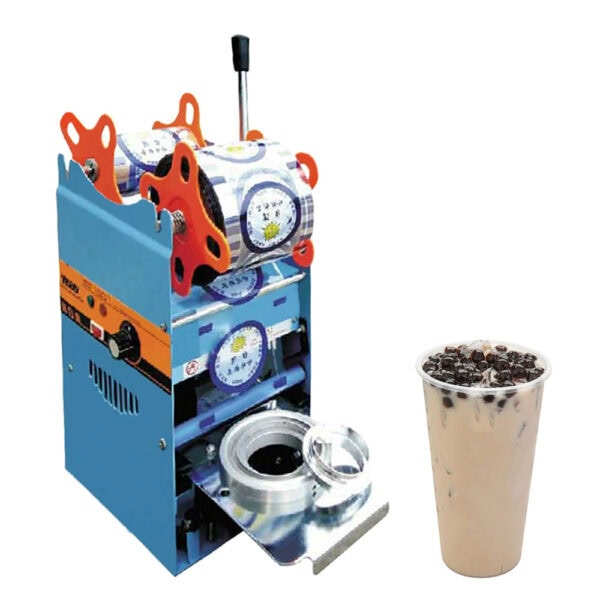Businesses face significant product leakage issues due to improperly sealed cups, which can harm both their reputation and sales. A well-functioning cup sealing machine offers an efficient solution, providing tight seals that enhance product preservation and prevent spills.
Cup sealing machines operate by using heat and pressure to adhere a sealing film to the top of a cup, ensuring an airtight seal. The process involves placing the cup under a sealing film, which is then pressed and cut to fit, securing the contents.
Let’s dive deeper into how these machines function, including their various components and working mechanisms.

Basic Operation of a Cup Sealing Machine
A cup sealing machine works by positioning a pre-filled cup under a sealing film that is then cut and sealed tightly to the cup. Once the cup is positioned, the machine lowers a heating element that applies sufficient heat to melt the sealing film onto the rim of the cup. Pressure ensures that the film bonds securely with the surface, creating an airtight seal.
The entire process ensures that the contents remain sealed, preserving freshness and preventing leakage. Machines such as a bottle capping machine follow similar principles, but are designed specifically for bottles rather than cups.
Heat Sealing Mechanism
Cup sealing machines primarily use heat sealing, where the film is melted to bond with the cup’s material. The heating element can be adjusted based on the material of the cup and film. Some machines allow for precise temperature control, ensuring that the seal is firm without causing damage to the cup or over-melting the film.
For example, many machines, including a labeling machine, use heat-based technology for applying labels onto various surfaces, similarly applying the right amount of pressure and temperature for optimal results.
Types of Cup Sealing Machines
There are both automatic and semi-automatic cup sealing machines. Automatic models handle everything from loading the cup to cutting and sealing the film without any human intervention, ideal for large-scale operations like bubble tea shops and fast-food chains. In contrast, semi-automatic machines require manual placement of the cups, but the sealing process itself is automated.
The automatic cup sealing machine is often paired with other packaging solutions like the packaging machine or filling machine in high-volume production lines.
Control Systems and Sensors
Modern cup sealing machines are equipped with advanced sensors to ensure accuracy and efficiency. These sensors detect the cup’s position and ensure the sealing film is aligned properly before initiating the sealing process. This precision reduces waste and ensures every cup is sealed uniformly.
Similar to a label printer, cup sealing machines can have built-in sensors to avoid misalignment, ensuring consistent results across batches.
Sealing Methods
The primary method used in cup sealing machines is heat sealing with pressure. However, some machines incorporate vacuum sealing, which removes air from the cup before sealing. This method is especially useful for preserving the freshness of food items and liquids over a long period.
Vacuum sealing can also be seen in the vacuum packaging machine, where the air is removed from the package before sealing, ensuring extended product life.
Materials Used for Sealing
Various materials can be used for the sealing film, including plastic, aluminum foil, and other biodegradable materials. The choice of film depends on the product’s nature and the desired shelf life. For example, food and beverages may require a durable plastic film to prevent contamination, while more environmentally conscious products might use biodegradable materials.
Applications in the Beverage Industry
Cup sealing machines are commonly used in the beverage industry, particularly for sealing cups of bubble tea, smoothies, and fresh juices. The machines not only prevent spills but also provide a professional and aesthetically pleasing seal that is popular with customers.
In operations like juice or tea shops, these machines work alongside other automated tools like a filling machine or flag labeling machine to streamline the process.
Maintenance and Troubleshooting
Regular maintenance of a cup sealing machine is essential to keep it running efficiently. Common issues such as film misalignment, inadequate sealing, or overheating can occur, but can be easily resolved with regular checks and cleaning. Keeping sensors and heating elements free of debris will prolong the machine’s lifespan and improve overall efficiency.
Speed and Efficiency
Automatic cup sealing machines can seal hundreds of cups per hour, making them a crucial part of operations in high-demand environments. Their speed and precision ensure that businesses can meet customer demand while maintaining product quality. Machines like these are often used in tandem with a powder packaging machine in industrial production lines to increase overall output.
Sealing Accuracy and Precision
Precision is key in cup sealing machines to avoid leaks and spills. The accuracy of the sealing process depends on the alignment of the film and the pressure applied during sealing. Adjustments can be made depending on the cup size and type of contents to ensure an optimal seal every time.
Other machines like the corner wrap labeling machine offer similar precision in applying labels accurately to package corners, showcasing the versatility of these automated systems.
Conclusions
Cup sealing machines offer a reliable solution for maintaining product integrity by using heat and pressure to seal cups. Their applications range from bubble tea shops to industrial food production, providing efficient and precise sealing to ensure product freshness and prevent spillage. Automated models increase productivity, especially when integrated with complementary machinery such as filling and packaging machines.









